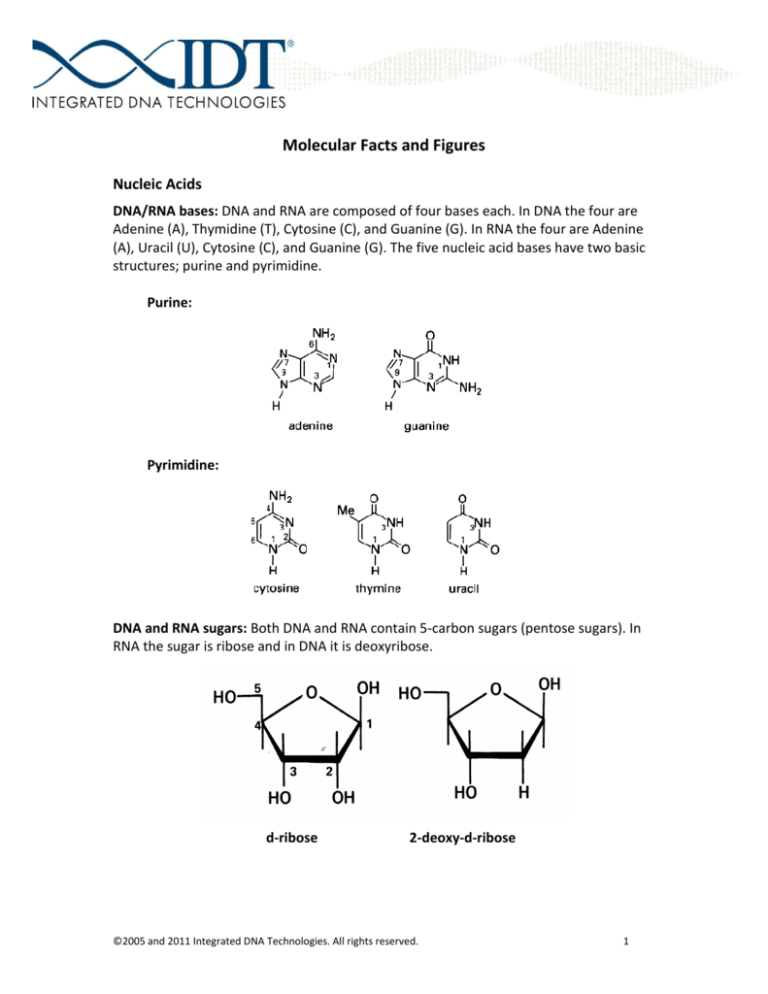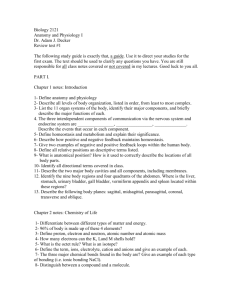
Molecular Facts and Figures
Nucleic Acids
DNA/RNA bases: DNA and RNA are composed of four bases each. In DNA the four are
Adenine (A), Thymidine (T), Cytosine (C), and Guanine (G). In RNA the four are Adenine
(A), Uracil (U), Cytosine (C), and Guanine (G). The five nucleic acid bases have two basic
structures; purine and pyrimidine.
Purine:
Pyrimidine:
DNA and RNA sugars: Both DNA and RNA contain 5-carbon sugars (pentose sugars). In
RNA the sugar is ribose and in DNA it is deoxyribose.
d-ribose
2-deoxy-d-ribose
©2005 and 2011 Integrated DNA Technologies. All rights reserved.
1
Nucleosides and Nucleotides: When a DNA or an RNA base is coupled with a pentose
sugar the unit is called a nucleoside. When a phosphate is added to the nucleoside, it
becomes a nucleotide, or nucleotide monophosphate.
NH2
NH2
N
N
N
O
P
-O
O
H
H
OH
H
H
O
O
O
-
H
Cytosine nucleoside
O
N
O
H
H
OH
H
H
H
Cytosine nucleotide
A DNA Strand: The correct structure of a single stand of DNA was produced by Professor
P.A.T. Levene in 1935. It took almost twenty years to discover the correct structure of a
complete DNA molecule.
B
Levene showed that the individual
nucleotide building blocks of DNA were
connected by phosphates linking the
pentose sugars.
HO
O
The bonds are called “3’ – 5’ phosphodiester linkages.”
H
O
H
H
H
O
The 3’ carbon of the sugar of one
nucleotide is linked to the 5’ carbon of the
sugar of the next nucleotide.
H
B
O-
P
O
O
H
H
O
H
H
H
O
B
O-
P
O
O
See: Portugal FH and Cohen JS. (1977) A
Century of DNA. MIT Press.
H
H
O
H
H
H
O
P
O-
O-
©2005 and 2011 Integrated DNA Technologies. All rights reserved.
2
DNA basepairs: The most critical aspect of DNA that led Watson and Crick to their
elucidation of the structure of the complete molecule is that the molecule was
composed of two chains, running in opposite directions, and held together by a specific
pairing of purine nucleotides with pyrimidine nucleotides; i.e., the purine Adenine with
the pyrimidine Thymine and the purine Guanine with the pyrimidine Cytosine. These
pairings are shown below.
General Nucleic Acid Data:
Average weight of a DNA basepair (sodium salt) = 650 daltons (1 dalton equals the mass
of a single hydrogen atom, or 1.67 x 10-24grams)
Molecular weight of a double-stranded DNA molecule = (# of basepairs x 650 daltons)
Total weight of the human genome = 3.3 x 109 bp x 650Da = 2.15 X 1012 Da. One dalton
is 1.67 x 10-24grams, so the human genome weighs 3.59 x 10-12 grams (10-12 grams is also
known as a picogram).
The human genome is 3.3 x 109 bp in length. If all the DNA in a single human cell was
placed end to end it would be six feet long. If all the DNA in all of the cells in a human
body was placed end to end it would reach the sun and back 600 times! That is 100
trillion cells x 6 feet divided by 93 million miles = 1200. (More facts about the human
genome can be found at www.sanger.ac.uk).
Another way of expressing an amount of DNA is in terms of molarity. One mole of
anything is given by Avagadro’s number 6.023 x 1023. Thus, 1 mole of DNA is 6.023 x 1023
molecules of DNA and 1 mole of bowling balls is 6.023 x 1023 bowling balls. It is often
necessary to express amounts of DNA in terms of both weight and number of molecules.
For example, one microgram (µg, 10-6 grams) of DNA pieces 1000bp long is 1.52
picomoles (pmol, 10-12 moles) and 1pmole of DNA pieces 1000bp long will weigh 0.66µg.
©2005 and 2011 Integrated DNA Technologies. All rights reserved.
3
Size and Molecular Weights of Some Nucleic Acids
Nucleic Acid
RNA:
transfer RNA (tRNA)
5S ribosomal RNA (rRNA)
16S rRNA
23S rRNA
28S rRNA
Length*
Weight (Da)
75nt
120nt
1900nt
3700nt
4800nt
2.5
3.6
6.1
1.2
1.6
x
x
x
x
x
104
104
105
106
106
3.1
9.9
3.6
4.6
5.3
9.2
1.8
2.0
2.0
2.2
2.6
3.2
x
x
x
x
x
x
x
x
x
x
x
x
109
109
1010
1010
1010
1010
1012
1012
1012
1012
1012
1012
DNA:
Escherichia coli (bacterium)
Saccharomyces cerevisiae
(yeast)
Dictyostelium discoideum
(amoeba)
Arabidopsis thaliana (mustard plant)
Caenorhabditis elegans
(worm)
Drosophila melanogaster (fruit fly)
Mus musculus
(mouse)
Rattus norvegicus
(rat)
Xenopus laevis (African clawed frog)
Homo sapiens
(human)
Zea mays
(corn)
Nicotiana tabacum (tobacco)
©2005 and 2011 Integrated DNA Technologies. All rights reserved.
4.7
1.5
5.4
7.0
8.0
1.4
2.7
3.0
3.1
3.3
3.9
4.8
x
x
x
x
x
x
x
x
x
x
x
x
106
107
107
107
107
108
109
109
109
109
109
109
bp
bp
bp
bp
bp
bp
bp
bp
bp
bp
bp
bp
4
Proteins
Proteins are composed of amino acids. These amino acids determine the structure and
function of the protein. Each amino acid is encoded in DNA by three-letter sequences
called codons. Some amino acids have only one codon, some have two different codons,
one has three different codons, and other have either four or six different codons. The
twenty amino acids and the codons that encode each of them are shown below.
Amino Acids, Abbreviations, and Molecular Weights
Amino Acid
3 Letter
1 Letter
MW
Alanine
Arginine
Asparagine
Aspartic Acid
Cysteine
Glutamic Acid
Glutamine
Glycine
Histidine
Isoleucine
Leucine
Lysine
Methionine
Phenylalanine
Proline
Serine
Threonine
Tryptophan
Tyrosine
Valine
89
174
132
133
121
147
146
75
155
131
131
146
149
165
115
105
119
204
181
117
Ala
Arg
Asn
Asp
Cys
Glu
Gln
Gly
His
Ile
Leu
Lys
Met
Phe
Pro
Ser
Thr
Trp
Tyr
Val
A
R
N
D
C
E
Q
G
H
I
L
K
M
F
P
S
T
W
Y
V
Amino Acid Structures:
Amino acids have the same basic structure. There is an “amine” group (NH3) on one
side and a “carboxy” group (COOH) on the other side of a central carbon. Also attached
to the central carbon is a side chain, or “R” group. Differences among the amino acids
are determined by the side chain.
R
H3N+
C
COO-
H
©2005 and 2011 Integrated DNA Technologies. All rights reserved.
5
Amino Acid
R-Group
Alanine
Non-polar, hydrophobic
-CH3
Valine
Leucine
Properties
CH3
-CH
Non-polar, hydrophobic
CH3
-CH2 CH
CH3
CH3
Non-polar, hydrophobic
CH3
Isoleucine
-CH
CH2
CH3
Non-polar, hydrophobic
CH3
CH2
CH2
Proline
Non-polar, hydrophobic
CH2
Methionine
-CH2 - CH2- - S - CH3
Non-polar, hydrophobic
Phenylalanine
-CH2
Non-polar, hydrophobic
Tryptophan
-CH2 – C = CH
NH
Non-polar, hydrophobic
Glycine
-H
Polar, hydrophilic
Serine
-CH2 - OH
Polar, hydrophilic
OH
Threonine
Polar, hydrophilic
-CH
CH3
©2005 and 2011 Integrated DNA Technologies. All rights reserved.
6
Cysteine
Asparagine
-CH2 - SH
Polar, hydrophilic, ionizable
-CH2 – CH = O
Polar, hydrophilic, ionizable
NH2
Glutamine
-CH2 - CH2 – CH = O
Polar, hydrophilic, ionizable
NH2
Tyrosine
-CH2
OH
Aspartic Acid
- CH2 – CH = O
Polar, hydrophilic, ionizable
Acidic, ionizable
OGlutamic Acid
-CH2 - CH2 – CH = O
Acidic, ionizable
O-
Lysine
Arginine
- CH2 – CH2 – CH2 – CH2 – NH3+
Basic, ionizable
- CH2 – CH2 – CH2 - NH – CH = NH2+
Basic, ionizable
NH2
Histidine
-CH2
NH+
Basic, ionizable
NH
©2005 and 2011 Integrated DNA Technologies. All rights reserved.
7
The Genetic Code
The search for the genetic code, that began with the publication of DNA structure in
1953, culminated in 1966 with the publication of the “genetic code dictionary” in Vol. 31
of Cold Spring harbor Symposia on Quantitative Biology. The code is “read” as shown
below.
Another way of representing the genetic code is:
Ala Arg Asn Asp Cys Glu Gln Gly His Ile Leu Lys Met Phe Pro Ser Thr Trp Tyr Val
GCU
GCC
GCG
GCA
CGU AAU GAU UGU GAG CAG GGU CAU AUU CUU AAG AUG UUU CCU UCU
CGC AAC GAC UGC GAA CAA GGC CAC AUC CUC AAA
UUC CCC UCC
CGG
GGG
AUA CUG
CCG UCG
CAA
GGA
CUA
CCA UCA
AGG
UUG
AGU
AGA
UUA
AGC
©2005 and 2011 Integrated DNA Technologies. All rights reserved.
ACU UGG UAU GUU
ACC
UAC GUC
ACG
GUG
ACA
GUA
8
Since the genetic code is read in three base “words” a protein composed of 300 amino
acids will require 900 bases of DNA. A 333 amino acid protein will weigh approximately
3.7 x 104 daltons (Da). Thus, in general,
Protein Weight (Da) Protein Length (amino acids) DNA Code (base pairs, bp)
10,000
90
270
30,000
270
810
50,000
440
1,320
100,000
900
2,700
Proteins range in size from as few as 30-40 amino acids to several thousand amino acids.
The average protein is estimated to be around 325 to 350 amino acids in length based
upon the average length of just about 1000bp for the coding sequence of a gene in
mammalian genomes.
©2005 and 2011 Integrated DNA Technologies. All rights reserved.
9







